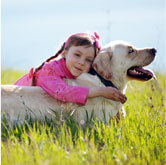Dog Sits on Command
Dog Sits on Command
How to Teach Your Dog to Sit on Command:
There are many reasons for wanting your dog to sit on command: when you are outside with him but are busy for a minute and don’t want him to wander around, or if you are with people who are afraid of dogs and you don’t want their fear to be intensified because Snoopy decided to smell them, just as they were deciding that fainting was the best reaction to the situation.
As explained before, here too, there are 3 methods: positive, confining and operative conditioning to help you, but they don’t all have the same level of accuracy and reliability:
-
- The positive approach: arm yourself with a titbit that your dog especially likes and hold it above him at the middle of his head from behind. This way he will have to sit to be able to see the food. Whilst doing this say ‘sit’ in a pleasant and friendly voice. When the dog sits, give him the titbit and at the same time praise him with words like ‘good dog’ and if the dog is the type who enjoys being petted (Link) give him a few pats too. This method illustrates only positive reward and therefore is the most humane. This also shows the method’s disadvantage – your dog is no sucker, he will only obey if he wants the titbit or he has nothing better to do. In spite of the reward offered he may prefer to scratch, chase a cat nap or wander away from you. You can be sure that you would have no chance against these external stimuli.
-
- The confining approach: put the dog on a short leash and hold him with one hand close to his throat. Pull the leash upward with a short movement, at the same time raising your free hand and say ‘sit’ in an authoritative tone. Slowly the dog will begin to understand, but he will also understand something else, that you are a threatening and frightening figure and that he should escape from you at the first opportunity. A scared and frightened dog is not an obedient dog for long, but a potentially destructive one.
- The operative conditioning approach: This creates effective synthesis between the two previous approaches. Hold the leash at almost the collar, preferably a ‘slip’ chain (Link), very close to the dog’s neck. Stretch the leash and say ‘sit’ in an authoritative but pleasant voice. Immediately afterwards press lightly on the dog’s hip bones at the top of the tail. This pressure is the only confining element used in this exercise, and is done gently so as not to frighten the dog. When the dog sits, clap your hands and praise him with cries of joy, so that he understands that he has done something positive. Repeat the exercise for 5 or 10 minutes a day, and when you feel that the dog has absorbed the exercise, go on to the next stage – sitting without the leash. In contrast to the previous stage, where the pressure on the hip bones was accompanied by the simultaneous command ‘sit’, we now use a short pause between giving the command and the physical action. This time the physical action takes the form of a light tap on the dog’s hind quarters. Say ‘sit’ to the dog, if he sits immediately (within a second of the command), encourage and praise him. If not – tap him lightly on his rear. The tap should be given 1.5 seconds after the command. In both the first and second stages the frequency of the exercise is the same. In addition, in both stages, don’t let the dog get up in less than 20 seconds. If he stands within a shorter time than this, correct him with ‘no’ said firmly, but not crossly, and sit him again using the same method as before. Release of the dog from the sit is done by clapping the hands and saying at the same time ‘free’.
Come visit, and you will understand why most vets recommend us
For further details please contact Yoni Engelberg at the farm offices: +972-543-344-365, [email protected]





